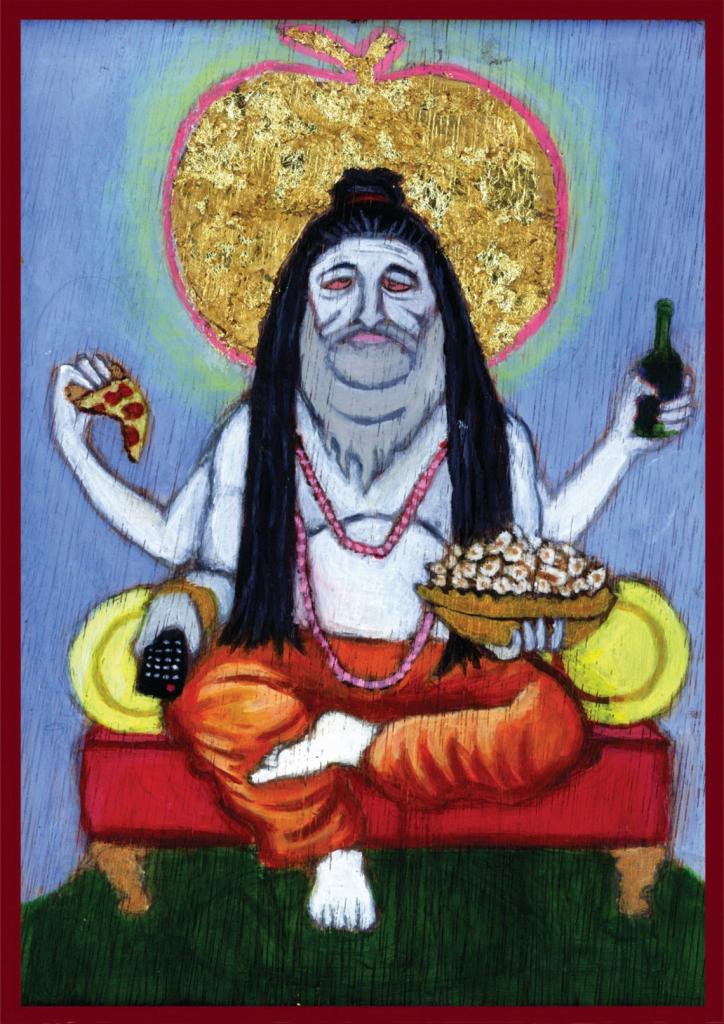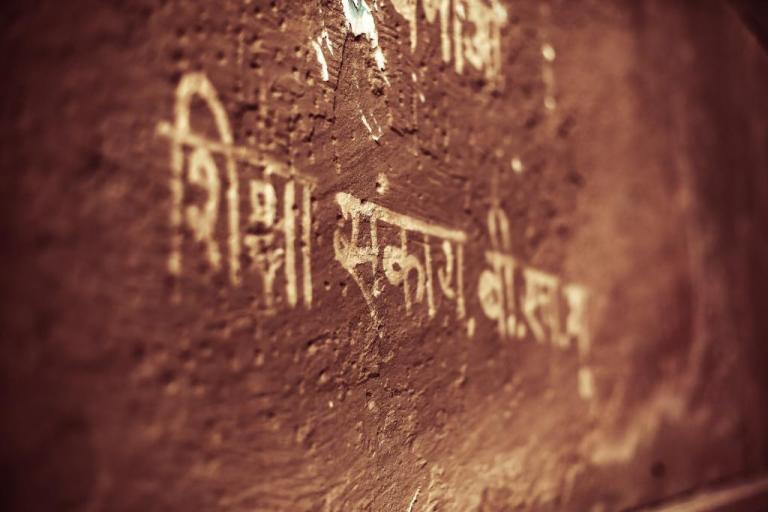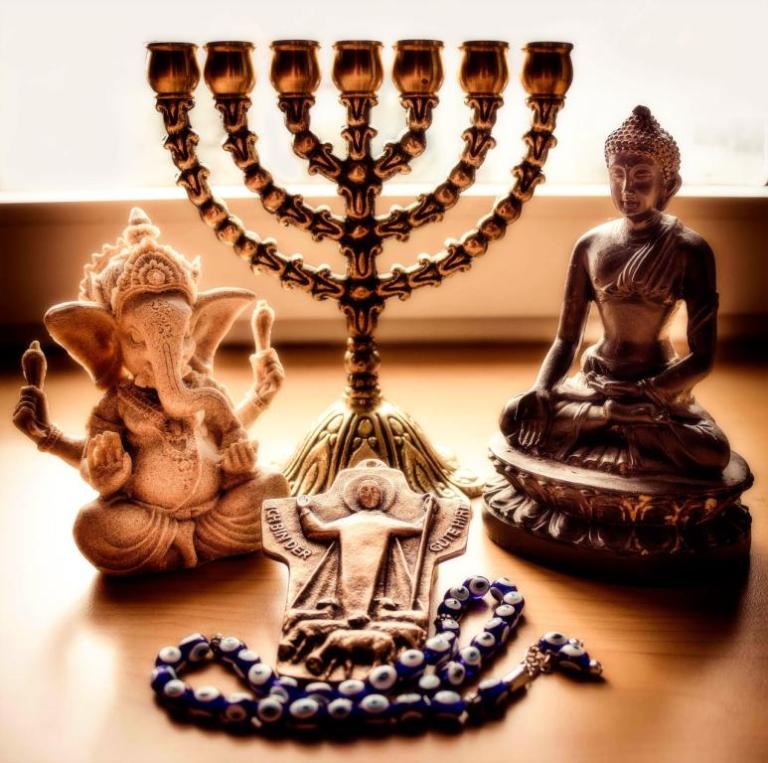I could’ve sworn yesterday was May 30, y’all. But it’s fitting that I got my dates mixed up, since May 31 is the fifth day of the Season of Confusion, which, according to the Discordian calendar, makes it Syaday, the feast of the Apostle Sri Syadasti.
His full name is Sri Syadasti Syadavaktavya Syadasti Syannasti Syadasti Cavaktavyasca Syadasti Syannasti Syadavatavyasca Syadasti Syannasti Syadavaktavyasca, which means: “All affirmations are true in some sense, meaningless in some sense, true and false in some sense, true and meaningless in some sense, false and meaningless in some sense, and true and false and meaningless in some sense.” Since it can be used as a mantra, his name is considered to be his primary contribution to Discordianism.

Sri Syadasti is first mentioned on page 00009 of the Principa Discordia, by none other than Eris Herself:
Tell constricted mankind that there are no rules, unless they choose to invent rules. Keep close the words of Syadasti: ‘TIS AN ILL WIND THAT BLOWS NO MINDS. And remember that there is no tyranny in the State of Confusion.
Further details about Syadasti are provided on page 00039, and the description is… okay, I’m not gonna lie. It’s problematic. So let’s brace ourselves and dive right into the middle of it.
Racism and Misogyny in an Otherwise Lovely Fake Religion
According to the Principia…
He is an Indian Pundit and Prince, born of the Peyotl Tribe, son of Gentle Chief Sun Flower Seed and the [Chieftess] Merry Jane. Patron to psychedelic type Discordians. Patron of the Season of Confusion. Sri Syadasti should not be confused with Blessed St. Gulik the Stoned, who is not the same person but is the same Apostle.
So right away there’s a mash-up of Indigenous American and East Indian symbology, which is more than a little shocking to find included in a book that encourages the abandonment of social mores and states unequivocally that gender is an illusion. My guess is that the authors were trying to play up the whole Season of Confusion thing by jumbling the two cultures, which is comprehensible but ultimately not condonable: As a comedic turn, it falls flat.
You’ll also notice that the word “Chieftess” is in brackets. This is because the specific word used in the text was, for a very long time, thought to be a generic Native American word that meant “woman,” but is actually a corruption of a Haudenosaunee word that means “female genitalia.” Despite its popular usage in the past, it is now understood to be an unacceptable ethnic and sexual slur.
That’s pretty awful. What should we do about it?
Well, we’ve got a few options:
- Cancel Discordianism.
- Pretend Sri Syadasti doesn’t exist and replace him with St. Gulik.
- Acknowledge that the founders of Discordianism said something unintentionally hurtful, and make every effort to not repeat their mistake.
Personally, I’m down with number three, while keeping in mind the disclaimer that Warner Bros. included at the beginning of their Looney Tunes Golden Collection DVD boxed set:
The cartoons you are about to see are products of their time. They may depict some of the ethnic and racial prejudices that were common in American society. These depictions were wrong then and are wrong today. While the following does not represent the Warner Bros. view of today’s society, these cartoons are being presented as they were originally created, because to do otherwise would be the same as claiming these prejudices never existed.
Long story short, erasing this section of the Principia would suggest that we’re trying to make our founders infallible. And they were awesome guys, but they were human, and it’s really important not to forget that. But something we can do is set aside the bad Indian jokes for now and look at the Sanskrit origin of Sri Sysadasti to figure out who he really is.

True, False, Meaningless, Everywhere
Sanskrit is a sacred language in Jainism, Hinduism, and Buddhism, and there is one figure who is worshipped in all three religions (as well as in ancient Rome, according to at least one 18th-Century source): Ganesha, the elephant-headed Opener of the Ways. Just as St. Gulik connects to Hermes/St. Expedite and Dr. Van Van Mojo groks with St. Cyprian, I strongly believe that Sri Syadasti was either inspired by or is an avatar of Ganesha. (Which would make Sun Flower Seed and Merry Jane Shiva and Parvati, respectively; an interesting thing to consider.)
My first encounter with Ganesha was in 1997, in the Theatre Arts section of a used book store. I was an intercollegiate competitive speaker at the time, and I was digging around for material to use at an upcoming tournament, when I came across a hardcover edition of Terrence McNally’s Pulitzer-nominated play A Perfect Ganesh. There are four characters in the show: Margaret and Katherine, best friends, each secretly dealing with a personal tragedy, who have decided to have a two-week adventure in India; “Man,” an ensemble performer who takes on numerous roles; and Ganesha, who plays Himself, but who is also an ensemble performer who takes on numerous roles. Because, as He says in the opening scene, “I am everywhere.”
It’s an incredibly powerful story, and it was my introduction to the concept of immanence — that is, God(s) in everything. I ended up developing a healthy respect for Ganesha because of it.

A few years later, on a lunch break, I saw a wooden Ganesha plaque tucked in among the all-natural candles at a local health food store. I’d wanted an icon of Ganesha ever since I read the play, although I’d never found one that particularly moved me. But this one grabbed my attention, so I bought it, went back to work and put it next to my office computer. I also eventually came across a sandalwood mala, which I kept next to His image, figuring He might like it.
I learned more about Ganesha here and there, but I never really developed any kind of religious practice around Him. And I never asked Him for anything, which is kind of odd, considering that’s His stock in trade: He’s the Remover of Obstacles, and He’s very good at it. But I just kept His likeness around, thought about Him whenever I saw it, sometimes picked up my mala and chanted His name 108 times or said a quick prayer, then went about whatever else I was doing.
And that was my entire history with Ganesha, up until the fateful afternoon I popped into the convenience store across the street from my apartment, on account of I was out of Fritos.
A Perfect Moment of Perfect Ganesh
“Hello!” said the Hindustani cashier as I piled processed snack foods on the counter. “How are you today?”
“Doing well, thanks!” I replied. Then, noticing the strand of prayer beads wrapped around his wrist, I said, “And hey, I like your mala.”
Cashier: “What?!” [suspiciously] “How do you know what a mala is?”
Me: “Um… because I have one, too.”

Cashier: “Did you get it as a souvenir somewhere?”
[Inner Me: He thinks you’re appropriating his culture. Nice going, colonizer.]
Me: “I found it at a curio shop over near the Galleria.”
Cashier: “Okay… but why do you have one?”
Me: “Well, sometimes I use it to meditate, and sometimes I use it to pray to Ganesha.”
Cashier: “You pray to Ganesha.”
Me: “I do.”
[uncomfortably long silence]
HCSC: “Pray to Him on Tuesdays. He likes milk and fresh fruit as offerings.”
Me: “Noted.”
Needless to say, my veneration has gotten a little more structured since then. And whether he’s fictitious or Ganesha or somewhere in between, Sri Syadasti has held doors open for me ever since.


















